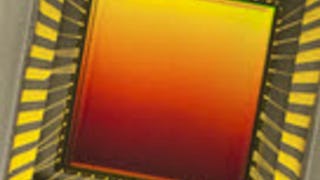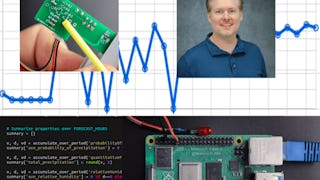Course two of this specialization is all about hardware physical layer and communication between elements of your project, how to troubleshoot high-speed signals when they don't work, and how to design your projects so they do work.


Communications and High-Speed Signals with Raspberry Pi
This course is part of Raspberry Pi Projects Specialization

Instructor: Drew Wilson
2,130 already enrolled
Included with
(13 reviews)
Skills you'll gain
Details to know

Add to your LinkedIn profile
4 assignments
See how employees at top companies are mastering in-demand skills

Build your subject-matter expertise
- Learn new concepts from industry experts
- Gain a foundational understanding of a subject or tool
- Develop job-relevant skills with hands-on projects
- Earn a shareable career certificate

There are 4 modules in this course
In this first module, we will discuss a variety of modern communications protocols and point out features that we will refer back to in later discussions. These are digital signals, but if you think digital communications is all 1's and 0's, I'd like you to change your thinking and start thinking of every signal as an analog waveform. We'll discuss what that means and why it's important when building projects with high-performance communications links. We'll introduce some well-known protocols and also the emergning I3C protocol, the successor to I2C. Lastly, we'll take an in-depth look at a type of circuit called an open-drain driver. This is how an IC communicates on an I2C (and I3C) bus and is a great example circuit for studying all sorts of real-world effects on high-speed signals. We'll use this open-drain configuration as an example throughout the entire course. You may have seen some of this information before but it's worth briefly seeing again as this is the foundation that we'll be referring back to throughout the whole course. And it's worth building a strong foundation now, because Module 4 wraps up everything we've learned into five very useful rules of thumb that you can you in all of your future projects. One more thing. I know I speak slowly, so feel free to use the Coursera video player feature to play the videos at 1.5x or 2x speed.
What's included
14 videos1 assignment
In Module two, we look into the physics of how high-speed signals are effected by real-world circuits and how that distortion effects our projects. We'll use math at times, but only to help develop an intuitive understanding. This is a critical part of developing the five Rules of Thumb in module 4. These valuable rules will help you troubleshoot and design circuits with high-speed signals in all sorts of future projects.
What's included
11 videos1 assignment
Everything we've discussed has considered signals to be voltages that change in time. Picturing signals strictly in the time domain is only half the story, so get ready to shift your mind into the frequency domain. This module introduces frequency-domain concepts and how we can use the frequency domain to deeply understand how real-world circuit effects distort signals and can cause communications errors in our projects. At the end of this module is two extra videos on decibels and filter terminology. Feel free to skip them if you're very familiar with the topic, or feel free to watch them out of order if you need a little more background in those topics to understand the ideas here in module 3.
What's included
12 videos1 assignment
After laying down a strong foundation in modules 1, 2, 3, we've finaly made it to module 4 and it's time to develop our five Rules of Thumb. These concepts were chosen for the rules of thumb in this module becuase they are extremely common trouble spots for new developers (and sometimes experienced developers, too). Each lesson builds on information in the earlier modules and distills a concept to an easy-to-remember rule that you can use on your future projects. Also included in teh resources is a handy one-page PDF summary of the five Rules of Thumb for you keep close by when you're working on your projects in the future.
What's included
10 videos1 reading1 assignment
Earn a career certificate
Add this credential to your LinkedIn profile, resume, or CV. Share it on social media and in your performance review.
Instructor

Offered by
Explore more from Electrical Engineering
 Status: Free Trial
Status: Free TrialUniversity of California, Irvine
 Status: Free Trial
Status: Free TrialJohns Hopkins University
 Status: Free Trial
Status: Free TrialJohns Hopkins University
 Status: Free Trial
Status: Free TrialJohns Hopkins University
Why people choose Coursera for their career




Learner reviews
13 reviews
- 5 stars
84.61%
- 4 stars
15.38%
- 3 stars
0%
- 2 stars
0%
- 1 star
0%
Showing 3 of 13
Reviewed on Oct 6, 2024
Excellent introduction of theory and applications.

Open new doors with Coursera Plus
Unlimited access to 10,000+ world-class courses, hands-on projects, and job-ready certificate programs - all included in your subscription
Advance your career with an online degree
Earn a degree from world-class universities - 100% online
Join over 3,400 global companies that choose Coursera for Business
Upskill your employees to excel in the digital economy
Frequently asked questions
To access the course materials, assignments and to earn a Certificate, you will need to purchase the Certificate experience when you enroll in a course. You can try a Free Trial instead, or apply for Financial Aid. The course may offer 'Full Course, No Certificate' instead. This option lets you see all course materials, submit required assessments, and get a final grade. This also means that you will not be able to purchase a Certificate experience.
When you enroll in the course, you get access to all of the courses in the Specialization, and you earn a certificate when you complete the work. Your electronic Certificate will be added to your Accomplishments page - from there, you can print your Certificate or add it to your LinkedIn profile.
Yes. In select learning programs, you can apply for financial aid or a scholarship if you can’t afford the enrollment fee. If fin aid or scholarship is available for your learning program selection, you’ll find a link to apply on the description page.
More questions
Financial aid available,

